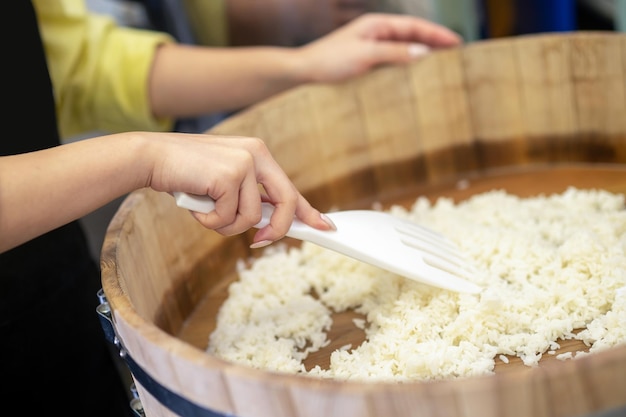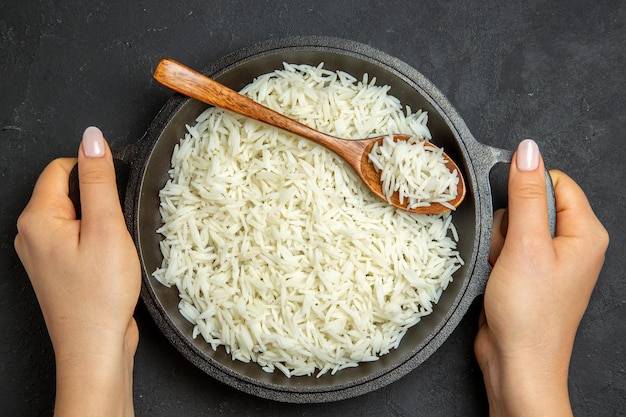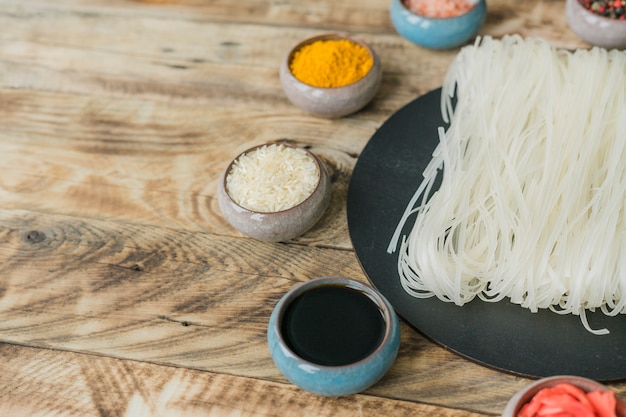Let's talk sticky rice. It's more than just a side dish, you know. It's a blank canvas for deliciousness, the perfect partner for countless Asian dishes, and honestly, it's pretty darn tasty even on its own with a drizzle of soy sauce and sesame oil. But, here's the catch: getting that perfect sticky rice isn't always a walk in the park. You might end up with a sticky mess that's either too hard or too mushy. It can be frustrating!
Well, fear not, fellow rice enthusiasts! I've been there, trying countless methods and experimenting with different ratios, and let me tell you, I've had my fair share of rice disasters. But through trial and error (and a few burnt pots!), I've learned some invaluable lessons that I'm eager to share with you. So, grab a cuppa, get comfy, and let's embark on a sticky rice journey together!
Part 1: Understanding Sticky Rice

Before we even consider the cooking process, it's crucial to understand what we're dealing with. Sticky rice, also known as glutinous rice, is a special type of rice packed with more starch than your typical long-grain rice. This extra starch is what gives it that unique sticky, almost gluey texture that we love. It's also what makes it a bit more finicky to cook than other rice varieties.
Choosing the Right Sticky Rice
The names can be a bit confusing, but here's the lowdown on the different types of sticky rice you might find:
- Sticky Rice: This is the most common term in English-speaking countries.
- Glutinous Rice: This emphasizes the high starch content.
- sweet rice: This name is often used in Asian countries.
- mochi rice: This sticky rice is specially used for making mochi, a traditional japanese rice cake.
Each type of sticky rice has a slightly different texture and purpose. Mochi rice is known for its super sticky, almost rubbery texture, perfect for making those chewy mochi treats. Regular sticky rice, on the other hand, has a softer, more pliable texture, ideal for sushi, rice bowls, and various Asian dishes.
The Importance of Rinsing Sticky Rice
One of the most important steps in cooking sticky rice is giving it a good rinse. This removes excess starch, which can make the rice overly sticky and clumpy. Think of it like washing away the glue! I always rinse my sticky rice until the water runs clear. It's a bit of a chore, I know, but trust me, it makes a big difference in the final texture.
The Perfect Water Ratio for Sticky Rice
The water ratio is another crucial element in achieving sticky rice perfection. Too much water will result in mushy rice, while too little will leave you with dry, hard rice. The general rule of thumb is a 1:1 ratio of sticky rice to water. However, this can vary depending on the type of rice, your cooking method, and personal preference. I've found that a 1:1.25 ratio works best for me, but the best way to find your perfect ratio is through experimentation.
The Right Pot for Cooking Sticky Rice
The pot you choose can also affect the final texture of your sticky rice. I prefer a heavy-bottomed pot, like a cast iron dutch oven. It distributes heat evenly and helps prevent scorching. You can also use a rice cooker, but I've found that the rice sometimes turns out a bit mushy in a rice cooker.
Part 2: Cooking Methods for Perfect Sticky Rice

Now that we've covered the basics, let's dive into the actual cooking process. There are a few reliable methods you can use to cook sticky rice, each with its own benefits and drawbacks.
Method 1: Stovetop Cooking
This is my go-to method for cooking sticky rice. It's simple, reliable, and gives you complete control over the cooking process. You can adjust the heat and time to your liking.
Instructions:
- Rinse the sticky rice thoroughly until the water runs clear. Drain it well.
- Combine the rice with the desired amount of water in your heavy-bottomed pot.
- Bring the pot to a boil over high heat, then cover it tightly with a lid. This will help to trap the steam and cook the rice evenly.
- Reduce the heat to low and simmer for 15-20 minutes, or until the rice is tender and most of the water has been absorbed.
- Remove the pot from the heat and let the rice rest, covered, for 10-15 minutes. This allows the rice to steam and finish cooking.
- Fluff the rice gently with a fork and serve immediately.
Method 2: Rice Cooker for Effortless Sticky Rice
For those who prefer a hands-off approach, a rice cooker is a fantastic option. It's super convenient, and you don't have to worry about overcooking the rice. Simply set it and forget it!
Instructions:
- Rinse the sticky rice thoroughly until the water runs clear. Drain it well.
- Add the rice and water to the rice cooker according to the manufacturer's instructions.
- Close the lid and press the "Cook" button. The rice cooker will automatically turn off when the rice is cooked.
- Let the rice sit in the rice cooker for a few minutes before serving.
Method 3: instant pot for Quick and Easy Sticky Rice
If you're a fan of the Instant Pot, you can also cook sticky rice in it. It's a great option for those who want a faster cooking time.
Instructions:
- Rinse the sticky rice thoroughly until the water runs clear. Drain it well.
- Combine the rice and water in the Instant Pot.
- Close the lid and seal the valve.
- Cook on high pressure for 4-5 minutes, then let the pressure release naturally for 10 minutes.
- Release the remaining pressure manually and carefully open the lid.
- Fluff the rice with a fork and serve immediately.
Part 3: The Art of Fluffing Sticky Rice

You've cooked your rice, it's all fluffy and fragrant, but now comes the art of fluffing. It might seem like a small detail, but it's essential for ensuring that your rice has the perfect texture and isn't clumpy.
I use a fork to gently fluff the rice, but you can also use a rice paddle or even chopsticks. The key is to be gentle and not to overwork the rice, as this can make it mushy.
Fluffing the rice right after it's cooked is crucial for creating those individual grains and preventing them from sticking together. It also helps to release any excess moisture, which can make the rice too wet.
Part 4: Tips for Perfect Sticky Rice
Here are some additional tips to help you achieve sticky rice perfection:
- Use filtered water: This will help to ensure that your rice is cooked evenly and doesn't have an off-flavor.
- Soak the rice: Soaking the rice for 30 minutes before cooking can help to improve its texture. It allows the rice to absorb water more evenly and become more tender.
- Don't stir the rice: Once the rice starts to cook, resist the urge to stir it. Stirring can break the rice grains and make it mushy.
- Keep an eye on the rice: Once the rice starts to absorb the water, the surface will begin to look dry. You can check if the rice is cooked by carefully removing the lid and gently pressing on a grain. It should be soft and slightly translucent.
- Let the rice rest: Allowing the rice to rest for 10-15 minutes after cooking allows it to steam and finish cooking. This will make it even more tender and flavorful.
- Add a pinch of salt: A pinch of salt can enhance the flavor of the rice.
- Store leftovers properly: Leftover sticky rice can be stored in an airtight container in the refrigerator for up to 3 days. You can reheat it by steaming it or microwaving it with a little bit of water.
Part 5: Flavoring Your Sticky Rice
Now that you've got the perfect sticky rice, let's talk about flavoring it. You can keep it simple with a drizzle of soy sauce and sesame oil, or get creative with different herbs, spices, and other ingredients. Here are a few ideas to get you started:
Simple Flavorings for Sticky Rice
- Soy sauce and sesame oil: This is a classic combination that's always delicious.
- Butter and salt: For a simple, comforting flavor, add a knob of butter and a pinch of salt.
- Sesame seeds and seaweed: This adds a nice nutty and salty flavor.
Asian-Inspired Flavorings for Sticky Rice
- Chili oil and garlic: This adds a spicy kick to the rice.
- Fish sauce and lime juice: A refreshing and tangy combination that's perfect for summer.
- Ginger and scallions: This adds a subtle, savory flavor.
Sweet and Savory Flavorings for Sticky Rice
- Coconut milk and mango: A sweet and tropical combination.
- Honey and cinnamon: For a warm and comforting flavor.
- Maple syrup and pecans: A sweet and nutty combination.
Part 6: Delicious Sticky rice recipes
Now that you've mastered the art of cooking sticky rice, let's put it into action with some delectable recipes!
1. Thai Green Curry with Sticky Rice
This is a classic Thai dish that's both flavorful and comforting. The green curry paste is made with fresh herbs and spices, and the coconut milk gives it a rich and creamy texture. The sticky rice absorbs the delicious curry sauce, making every bite a delight.
2. Vietnamese Pho with Sticky Rice
This is a Vietnamese noodle soup that's both flavorful and comforting. The broth is made with beef bones and spices, and the noodles are served with thinly sliced beef, fresh herbs, and sticky rice. The sticky rice provides a contrasting texture to the soft noodles and flavorful broth.
3. Japanese Sushi
Sticky rice is an essential ingredient in sushi. It's used to make the sushi rice, which is then rolled with various fillings, like fish, vegetables, and eggs. The sticky rice holds the sushi together and creates a pleasant texture that complements the fillings.
4. Korean Bibimbap
This is a Korean mixed rice dish that's both colorful and delicious. The rice is mixed with a variety of vegetables, meat, and a fried egg. The sticky rice acts as the base for all the other ingredients, creating a cohesive and flavorful dish.
5. Sticky rice pudding
This is a sweet and comforting dessert that's perfect for a cold winter's day. The rice is cooked in milk and sugar, and then flavored with spices like cinnamon and nutmeg. The sticky rice adds a delightful texture to the creamy pudding.
Part 7: Sticky Rice FAQs
Let's address some of the most common questions about sticky rice!
1. Can I substitute regular rice for sticky rice?
Unfortunately, no. Regular rice and sticky rice have different starch contents, leading to vastly different textures. Regular rice will be fluffy and separate, while sticky rice will be chewy and sticky. You won't get the same result if you try to swap them.
2. What happens if I use too much water?
Using too much water will result in mushy, overcooked rice. The rice won't have that distinct chewy texture that we love. It's best to stick to the recommended water ratio.
3. What happens if I use too little water?
Using too little water will leave you with dry, hard rice that's not cooked through. It will have a crunchy texture instead of the soft, chewy texture we're aiming for.
4. Can I cook sticky rice in the microwave?
You can try cooking sticky rice in the microwave, but it's not the most reliable method. The rice may not cook evenly, and it can easily become overcooked and mushy. It's better to stick to the stovetop, rice cooker, or Instant Pot methods for consistent results.
5. What can I do with leftover sticky rice?
There are endless delicious ways to use leftover sticky rice! You can whip up a quick fried rice, add it to a stir-fry, make sticky rice balls, or even use it as a base for a savory salad. Get creative!
Part 8: A Final Note on Perfect Sticky Rice
So there you have it, my guide to cooking the perfect sticky rice! Remember, it's all about finding what works best for you. Don't be afraid to experiment with different ratios, cooking methods, and flavorings. And most importantly, have fun!
I hope this guide has helped you on your journey to sticky rice perfection. Now, go forth and create some culinary magic!
Everyone is watching

Corn on the Cob: The Ultimate Guide to Perfectly Cooked Ears
Healthy MealsAh, corn on the cob. Just the name evokes images of sunny days, barbecues, and that sweet, juicy flavour that ...

Perfect Pork Roast Oven Cooking Time: A Guide to Delicious Results
Healthy MealsThere's something truly satisfying about a perfectly roasted pork. The aroma alone is enough to make your mout...

Ham Cooking Time: How Long to Bake, Smoke, or Boil a Delicious Ham
Healthy MealsAh, ham. It's a classic, isn't it? A real crowd-pleaser, especially around holidays. And when done right, it'...

Scallops: The Ultimate Guide to Perfect Cooking
Healthy MealsAh, scallops. Those delicate, sweet, and utterly delicious morsels of the sea. They hold a special place in my...

Spaghetti Squash: The Ultimate Guide to Cooking and Serving
Healthy MealsRemember that time you saw spaghetti squash at the supermarket, looking all bumpy and strange, and thought, "W...
